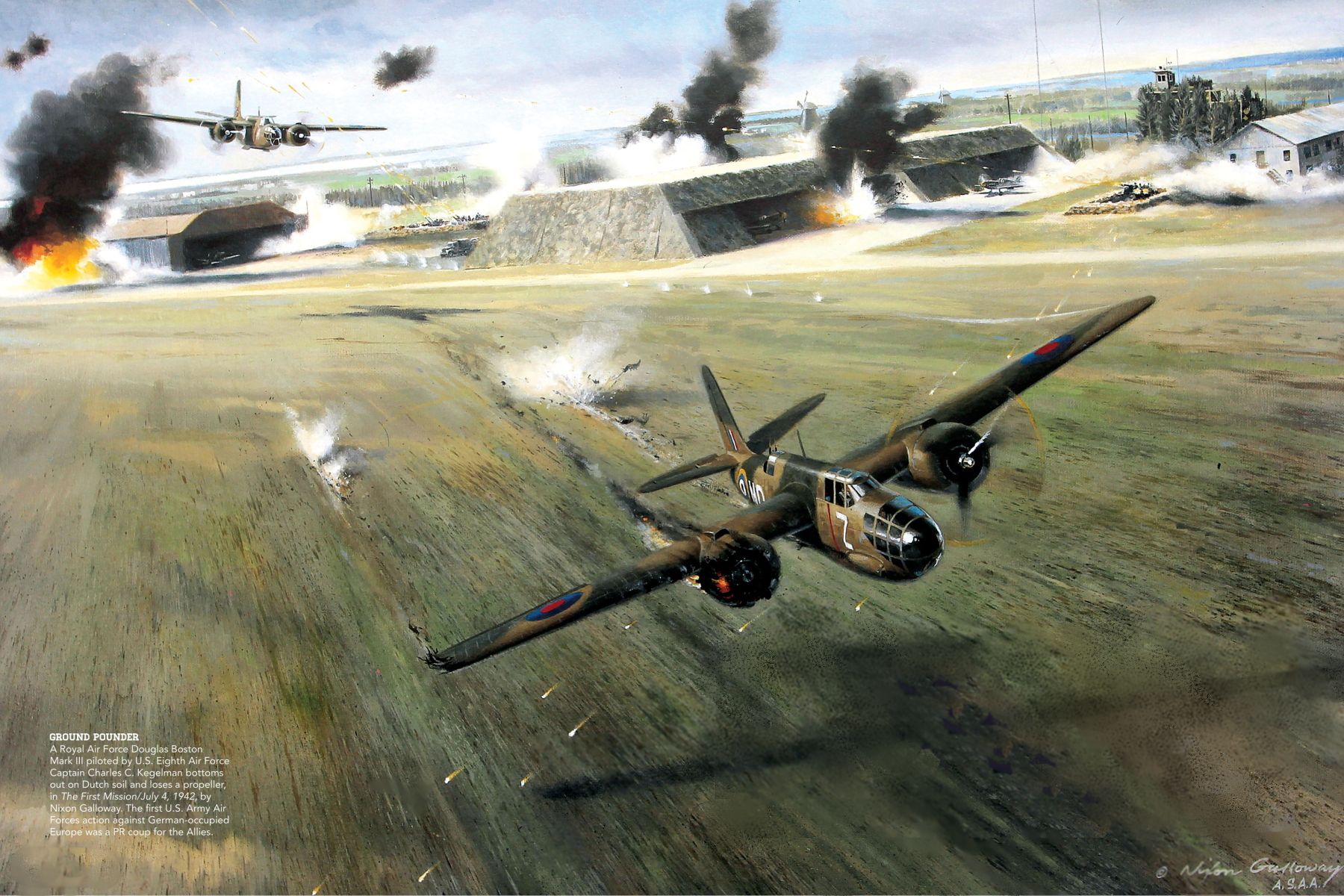
Captain Charles Kegelman USAAF and an American crew piloted one of the twelve Bostons led by Squadron Leader J. S. Kennedy DFC that took part in a Circus (C-195) against the Hazebrouck marshalling yards on 29 June, the first time since 1918 that Americans had operated from England. Also on this operation Typhoons were used as high cover for the first time. Bombing was from 13,000 ft, no flak was encountered and hits were scored on the north-east edge of the yards, and on the railway embankment north-west of the town.
The first 8th Air Force involvement in a mission to drop bombs on an enemy target was on 4 July 1942, Independence Day, when six of the twelve A-20 Bostons belonging to 226 Squadron RAF at Swanton Morley, Norfolk, carried American crews of the 15th Bomb Squadron (Light) in attacks on four airfields in Holland. The senior-ranking US officer was Captain Charles Kegelman (seen here second from left), who attacked De Kooy airfield in AL750/Z, crewed by Lieutenant R. M. Dorton, navigator, Sergeant Bennie Cunningham, rear gunner, and Technical Sergeant R. L. Goley, dorsal gunner. Kegelman’s starboard engine took a direct hit and burst into flames, and the propeller flew off. The right-wing tip struck the ground, and the fuselage actually bounced on the surface of De Kooy aerodrome, tearing a hole in the belly of the bomber. Lifting the Boston back into the air on one engine, Kegelman headed for the Channel. A flak tower on Den Helder airfield opened up, and the young captain returned fire with his nose guns. He lifted the Boston over the tower and headed for England with the right engine on fire. The fire went out over the Channel, and Kegelman continued home to Swanton Morley, hugging the waves across the North Sea. Charles Kegelman rose rapidly in promotion. From April to 8 November 1943 he was a lieutenant colonel in command of the 48th Fighter Group at William Northern Field, Tennessee. On 12 November he assumed command of the 337th Fighter Group at Sarasota, Florida, as a full colonel. On 16 November 1944 be assumed command of the 42nd Bomb Group at Sansapor, New Guinea, which by March 1945 was operating North American B-25 Mitchells from Moratai. On 10 March Kegelman’s aircraft was involved in a midair collision with his wingman and he was killed. Kegelman airfield, near Cherokee, Oklahoma, is named in his memory.
On Monday, 29 June twelve Bostons of 226 Squadron, led by Squadron Leader J. Shaw Kennedy, a popular red-haired ace flyer, attacked the marshalling yards at Hazebrouck, escorted for the first time on a Circus raid by Hawker Typhoons. A US crew, captained by Captain Charles Kegelman, flew one of the Bostons, for the first ever US sortie from England. Bombing from between 12,500 and 13,000 ft, the formation recorded two hits on the railway lines at the eastern end of the yard and one or two were seen to burst on lines and sheds at the western end. The rest of the bombs fell on buildings to the south and north. No flak was encountered by the formation while over the target and all the aircraft returned. Not so fortunate were the escorting Spitfires, who encountered German fighters en route to the target, claiming three destroyed for the loss of five of their own.
On 4 July six American crews joined six crews from 226 Squadron for Independence Day attacks on De Kooy, Haamstede, Bergen-Alkmaar and Valkenburg airfields in Holland. General Dwight D. Eisenhower, newly arrived in England to command the US Forces in the European Theatre of Operations (ETO), was at Swanton Morley to see them off, at around 0710. When they returned it was immediately obvious that the raids had been less successful than the occasion had demanded. Three aircraft were missing, two of them crewed by Americans. At De Kooy Lieutenant F. A. `Jack’ Loehrl’s Boston had been hit by flak and only Lieutenant Marshall Draper, the bombardier, survived to be made a PoW. After bombing Bergen aan Zee (Alkmaar) Lieutenant W. G. `Stan’ Lynn’s Boston was also hit by flak; it broke up in mid-air, killing all on board. Unteroffiziers Erwin Grütz in Bf 190F-4 `White 6′, Wrk Nr 7423 and Johannes Rathenow in his Fw 190A-3, both of IV./JG1, took off as their airfield at Bergen aan Zee was being bombed and sped after the Bostons. Grütz was shot down and killed by return fire and he crashed near the base. Rathenow caught up with Pilot Officer C. M. `Hank’ Henning and shot him down into the sea at 0830 hours, 12 miles west of Callantsoog. It was IV Gruppe’s first success. The most amazing piece of flying was carried out by Captain Kegelman, whose Boston took a hit in the starboard engine; it burst into flames and the propeller flew off. Kegleman’s right wing tip struck the ground and the fuselage actually bounced on the surface of the aerodrome, tearing a hole in the belly of the bomber. Kegelman nursed the Boston all the way back to Swanton, a feat that earned him the DSC. Flight Lieutenant R. A. `Yogi’ Yates-Earl and his observer, Pilot Officer Ken Houghton, were awarded the DFC and his gunner, Sergeant Ted Leaver, the DFM, for their part in the attack on Bergen-Alkmaar.